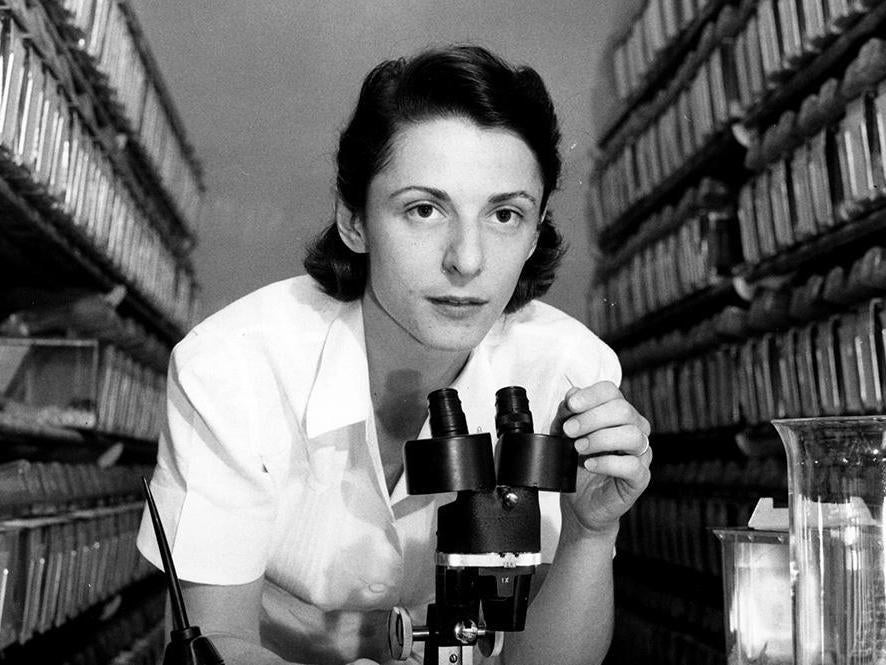Liane Russell: Geneticist who highlighted the danger of X-rays on embryos
Her research was a landmark in the study of genetic mutations and she was also a prominent conservationist

Liane Russell was a refugee of Nazi Europe who became one of the most distinguished female scientists of her era, building a colony of more than 200,000 laboratory mice that she used to demonstrate the importance of protecting developing embryos from X-rays and other forms of radiation.
Russell, who has died aged 95, spent the early years of her life in Vienna, where her father was a chemical engineer and her mother was a voice teacher. Russell’s family, which was of Jewish heritage, managed to escape Austria after its annexation by Nazi Germany in 1938, but only by relinquishing their home, her father’s company and their belongings. They ultimately settled in the US, where Russell pursued her scientific studies and career.
In 1947, she and her husband, fellow scientist William Russell, joined what became the Oak Ridge National Laboratory in Tennessee. Both had doctorates in zoology and specialised in genetics. Together they built the “Mouse House”, as their colony of laboratory mice was known, with the goal of using mice to better understand the effect of radiation on living things, particularly mammals.
It was a matter of pressing concern at the time: two years earlier, the US had ended the Second World War by dropping atomic bombs – produced through the Manhattan Project conducted at Oak Ridge – on the Japanese cities of Hiroshima and Nagasaki. With the onset of the Cold War between the US and the Soviet Union, the threat of nuclear war loomed, and along with it fears about the health effects of nuclear fallout.
Russell’s work yielded findings with relevance far beyond such cataclysmic eventualities. She became known chiefly for her research showing that radiation, such as from X-rays, harms embryos, particularly in the early stages of development.
With her husband, Russell studied generations of mice, which are useful for laboratory research because of their genetic similarity to humans. She had begun similar research as a graduate student at the University of Chicago.
“I irradiated mouse embryos in different stages of development,” she once said, “and I ended up producing baby mice with strange abnormalities, such as misshapen legs, toes fused together or kinky tails.”
According to the Atomic Heritage Foundation, Russell “discovered that there were critical moments in the mouse embryo’s development. For example, the mouse embryo will develop arms on day 11. Another example is that abnormalities do not show up until after day four of mouse embryonic development.”
Russell concluded that human embryos were most sensitive to the ill effects of radiation during the first seven weeks of their development. This window presented a particular danger for the many women who do not learn until after that point that they are pregnant, and led to the recommendation that women of childbearing age receive non-emergency X-rays only in the two weeks after their menstrual period, when pregnancy is least likely.
Because they upset existing practices, those 1952 recommendations “brought the wrath of radiologists down upon our heads, and unleashed a series of letters to the editor”, Russell later recalled. “Before long, however, the so-called 14-day (sometimes 10-day) rule became internationally accepted in radiological practice.”
By observing the manifestation of mutations in male or female mice, Russell also drew the conclusion that male mice carried the Y chromosome. Her findings “have been the benchmark for the study of mutations in mammals and genetic risk assessment worldwide”, according to a 1994 citation accompanying the Enrico Fermi Award from the US Energy Department.
Liane Ruth Brauch was born in Vienna in 1923. After the Anschluss, her family fled to Belgium, then to England and finally to the US. She received a bachelor’s degree in chemistry from Hunter College in New York City in 1945, became a US citizen in 1946 and received her PhD from the University of Chicago in 1949.
Russell and her husband were prominent conservationists in Tennessee and were both inducted into the National Academy of Sciences. In 2013, Oak Ridge National Laboratory created the Liane B Russell Distinguished Early Career Fellowship to assist young researchers, particularly women and minorities. (Russell had retired from Oak Ridge in 2002.)
“In my life, I was very fortunate in being given opportunities to pursue my own ideas in exciting research areas,” Russell said at the time. “But this is, sadly, not the case for many young women hoping for scientific careers and ending up in merely supporting roles, perhaps doing only routine jobs.”
Her husband died in 2003. She is survived by two children and two stepchildren.
Liane Russell, geneticist, born 27 August 1923, died 20 July 2019
© Washington Post
Subscribe to Independent Premium to bookmark this article
Want to bookmark your favourite articles and stories to read or reference later? Start your Independent Premium subscription today.

Join our commenting forum
Join thought-provoking conversations, follow other Independent readers and see their replies